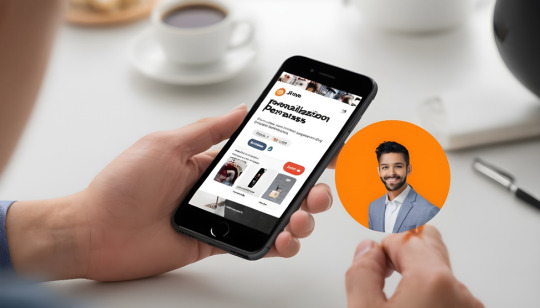Text
AI-Prompted Personalization: Tailoring B2B Journeys in Real-Time
Craft dynamic B2B customer experiences with AI-powered prompts. Discover effective strategies for real-time content personalization and boost conversions.
Personalization is now required in today’s dynamic B2B environment; it is no longer a choice.

Understanding AI-Prompted Personalization
AI Personalization refers to the provision of extremely targeted goods, services, messages, and other materials to individual recipients.
It is about leveraging AI’s ability to analyze vast amounts of data by carefully customizing brands’ replies for individual users, rather than relying on generic learning behavioral attributes and general customer demographic information as the basis for marketing and creating B2B real-time customer experiences.
What is AI personalization?
Artificial intelligence personalization is predicated on distinct customer data inputs and information extracted from thousands of customer interactions, such as browsing and purchase history, social media interactions, demographic trends, and behavioral data, customer service interactions, customer feedback via surveys, and more.
The power of AI-driven personalization lies in creating dynamic content for B2B marketing since personalization is both the style and substance of valuable content. This involves creating interesting infographics for readers who learn best visually, captivating videos for viewers who would rather watch, and detailed articles for readers who want to read about specific topics in detail. The foundation of demand-generation tactics and account-based marketing (ABM) is this personalized approach to content. For any specific audience, it is not just about what you say, but rather how well you say it.

4 Steps to Produce Personalized AI Content for B2B
Step 1: Create Data-Driven Personas using AI
The secret to creating material that has an impact on B2B real-time customer experience is knowing the audience. Businesses may learn a great deal about the wants and perceptions of their customers by collecting feedback from them through social media comments and reviews. Then, this data may be analyzed by AI-powered tools like Delve or HubSpot Make My Persona to find hidden trends and patterns.
This information can also be used to develop comprehensive personas that represent various client categories. The proper audience will find great resonance in the content material thanks to this data-driven strategy.
Step 2: Create Topic Ideas Using AI and Your New Persona
AI can be used to come up with topics that will appeal to the new persona. By analyzing customer feedback and social media comments, AI tools can identify popular topics, common problems, and frequently asked questions. This information can be used to create content that matches the audience persona’s interests and needs. To start the content marketing process, connect the challenges faced by the target audience with a core topic area. List the three to five content pillars that the business image is supported on. Use these pillars to generate topic ideas based on the audience persona’s struggles.

Step3: Repurposing Content
This step in B2B content marketing involves updating existing content to match the target audience’s persona. Instead of starting from scratch, it’s more effective to repurpose successful content and customize it for the targeted audience. AI can help with this process. Use tools like GA4 to analyze the analytics and find the most popular content among the audience. This information can be used as a basis for repurposing content.
For example, GA4 can be used to identify the most successful blog post during a specific time. To incorporate persona insights, take the chosen blog content and customize an AI tool with the characteristics of the persona. Then, ask the AI to generate topic ideas based on the blog content and the persona’s interests. Using AI Prompted personalization to transform existing content into highly personalized content can greatly benefit your content strategy. This method saves time and resources while ensuring that your content deeply resonates with your intended audience, ultimately enhancing the effectiveness and impact of your marketing efforts.
Step 4: Building Persona Centric Campaign
In the world of B2B marketing, it is important to listen to customers and use their insights in campaigns. AI tools like Jasper, to help turn customer conversations into effective marketing content. In the first step, collect customer insights and create personas using AI technology and information from customer reviews, interviews, and call transcripts. Using an AI tool called Claude, businesses can analyze conversations and extract important themes and insights from them, which represent the ‘voice of the customer.’ This is called social listening which can help in communicating with the audience effectively.
The information gathered by Claude is then used to create a detailed brief. Setting up a campaign in Jasper involves using its ‘Campaign’ feature to create multiple content assets at once based on a brief prepared previously. The brief, generated by Claude, is inputted into Jasper, and adjusted to match the brand’s voice and persona.
One special feature of Jasper is its ability to be customized to the company’s style and preferences through ‘seasoning’ documents. By providing these documents, businesses can ensure that Jasper’s content aligns with their brand voice and appeals to the target audience. This entire setup can produce a first draft of different types of content such as blog ideas, emails, landing page copy, social content, and FAQs.
Key Applications of AI Personalization
Product Recommendation
To offer tailored product recommendations, AI-powered recommendation engines examine a variety of data sources. Machine learning (ML) is being used by companies such as Amazon to lower abandoned cart rates and improve consumer experience.
Ad Targeting
AI uses customer information to present tailored adverts that boost click-through rates and engagement. Platform platforms such as Facebook use AI-powered targeting to display appropriate adverts based on user demographics, interests, and actions.
Content Personalization
AI uses information from social media activity and browser history to present content tailored to each user. AI is used by businesses like Warner Bros. Discovery and Spotify to provide personalized suggestions and increase user engagement.
AI-Driven Dynamic Pricing
AI modifies prices in response to many factors, such as market developments and consumer behavior. AI is used by sectors such as airlines and Uber to implement dynamic pricing strategies.
The Future of AI-Prompted Personalization
In an ever-expanding B2B landscape ecosystem, AI-powered personalization has emerged as a game changer. Whether it’s navigating the enormous diversity of products on e-commerce platforms, AI recommendation and customization engines are quickly becoming important tools for improving user experiences. AI personalization benefits both consumers, who experience increased happiness, and businesses, who discover entirely new areas of competitiveness.
The days of entering a store with only a few hundred items to choose from are long gone. The digital revolution has created a new universe with an overwhelming number of opportunities. Choice overload frequently leads to no choice, with an average 2023 online shopping cart abandonment rate of 69.99%. Navigating this sea of options without AI-powered recommendation engines is a difficult task, and closing even a small fraction of those abandoned carts has substantial revenue potential.
Challenges and Opportunities for AI-Powered Personalization
While AI-powered personalization has numerous advantages, it also raises questions about data protection and ethical use. Collecting and analyzing user data to provide tailored experiences necessitates striking a delicate balance between customization and protecting individuals’ privacy rights.
Regional governments, such as the EU’s General Data Protection Regulation, govern most privacy rights. Businesses should prioritize data protection, openness, and consent to ensure ethical AI practices—Apple is a wonderful example. The installation of strong privacy rules and adherence to regulatory frameworks are only the beginning of how to build consumer trust and mitigate potential hazards, and they should not be overlooked.
To thrive in the age of AI-powered personalization, organizations must shift their focus from purchasing technology to purchasing outcomes. Outcomes in AI can take several forms, including service-level agreements, operational costs, and, in terms of privacy, compliance guarantees. However, it is just as important to identify partners who share your business objectives and prioritize generating genuine value. Furthermore, as cloud technology costs rise, so do the commercial stakes of failure, emphasizing the importance of outcomes.
Conclusion
As we wrap our look at AI-prompted personalization in the B2B sector, we can see how this technology has the potential to transform customer experiences in real-time. With advances in natural language processing, sentiment analysis, and machine learning, businesses can obtain a better understanding of their customers’ requirements and preferences, resulting in more tailored and targeted interactions.
Ready to harness the power of AI-prompted personalization for your B2B strategy? You can enroll in AI Cert’s AI+ Prompt Engineer™ certification to create and utilize effective prompts for exceptional customer experiences.
1 note
·
View note